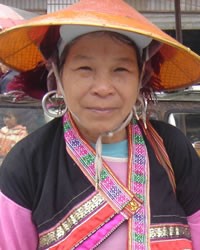The Huayao Tai are historically part of the great and ancient Tai people. One writer claimed that the Tai predate even the Chinese. "Gathered from Chinese and Burmese annals, as well as from their own, this history shows them to be older than the Hebrews or the Chinese themselves, to say nothing of such moderns as the Slavs, the Teutons or the Gauls."
Although the Huayao (Flowery Belted) Tai are a part of the officially constructed Dai nationality in China, they desire to be recognized as a separate minority group. Their language shares some similarities to Tai Lu, but the two are reported to be mutually unintelligible. It is possible that the Huayao Tai were a Tai group who originally lived in eastern Yunnan and migrated to their present location in the Xishuangbanna Prefecture. All Huayao Tai are also able to speak Tai Lu, which serves as the lingua franca of the region. The Huayao Tai observe different festivals from the other Tai groups. They do not celebrate Songkran, the annual Water Splashing Festival.
Huayao Tai women are instantly recognizable by their huge circular hats. They also carry with them a small bamboo basket, containing needle and thread, cosmetics, or food. The distinctive dress of the Huayao Tai differs from one area to another, "by variations in their dress and the ornaments which they wear." The Huayao Tai celebrate the annual Flower Street Festival.
The Huayao Tai practice a mixture of Theravada Buddhism and animism. "Animism in its Tai form ranges from the worship of natural force ... to include the practice of shamanism, sorcery and black magic."
A small number of Huayao Tai believers live in Mengyang County. In recent years evangelists have been active among them, establishing several house churches. Few Huayao Tai outside of Mengyang have heard of Christ. The Huayao Tai believers use the Tai Lu and Chinese Scriptures. Gospel recordings have recently been produced in the Huayao Tai language.
Without the guidance of Christ, these people will be lost in this life and the life to come. They need someone to go to them as Christ-bearers.
Pray for the spiritual blindness and bondage to the evil one to be removed so they can understand and respond to Christ.
Pray for the Lord to provide for their needs as a testimony of his power and love.
Pray that the Huayao Tai people will have a spiritual hunger that will open their hearts to the King of kings.
Pray for an unstoppable movement to Christ among them.
Scripture Prayers for the Huayao Tai in China.
Operation China, Asia Harvest, Copyrighted © Used with permission
| Profile Source: Joshua Project |

























